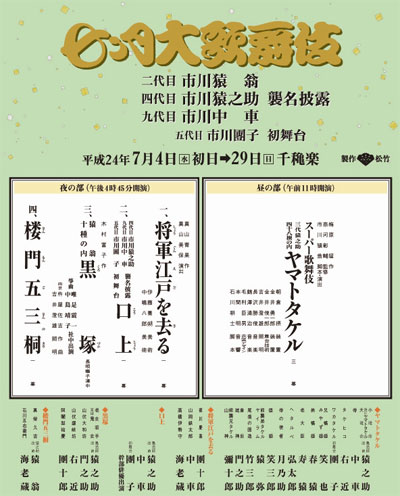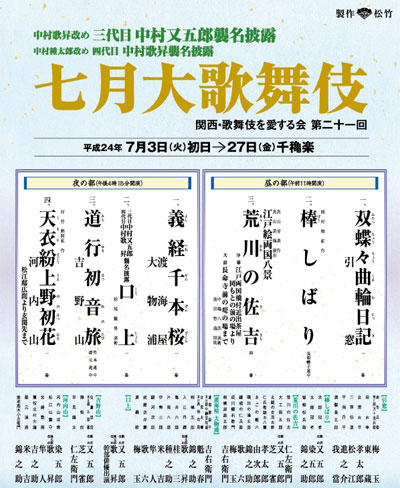| JULY 2012 |
| Shinbashi Enbuj˘ (T˘ky˘) |
| Dates | 2 ~ 26 July 2012 (Shichigatsu ďkabuki) July Grand Kabuki |
| MatinÚe |
Yamato Takeru |
| Evening | |
| Casting |
Ichikawa Ennosuke, Ichikawa En'˘, Ichikawa Danjűr˘, Ichikawa Ebiz˘, Ichikawa Danshir˘, Band˘ Takesabur˘, Band˘ Yajűr˘, Ichikawa Chűsha, Ichikawa Danko, Ichikawa Monnosuke, Ichikawa Ukon, Ichikawa Tsukinosuke, Ichikawa Emisabur˘, Ichikawa Emiya, Ichikawa Shun'en, Ichikawa En'ya, Ichikawa Juen, Ichikawa K˘tar˘ |
| Comments |
Second month of the great 2 shűmei / 2 hatsubutai for 3 generations of Omodakaya actors! Ichikawa En'˘ II and Ichikawa Ennosuke IV celebrate their shűmei. Ichikawa Ennosuke III's son Ichikawa Chűsha IX and Ichikawa Ennosuke III's grandson Ichikawa Danko V celebrate their hatsubutai.
|
 |
| Sh˘chikuza (ďsaka) |
| Dates | 3 ~ 27 July 2012 (Kansai Kabuki o Ai Suru Kai Shichigatsu ďkabuki) The 21st Kansai Kabuki Lovers Society July Grand Kabuki |
| MatinÚe | |
| Evening |
|
| Casting |
Nakamura Kichiemon, Kataoka Nizaemon, Nakamura Baigyoku, Kataoka Gat˘, Nakamura Shibajaku, Nakamura Kaishun, Nakamura Matagor˘, Nakamura Kash˘, Kataoka Takatar˘, Nakamura Kinnosuke, Nakamura Karoku, Nakamura T˘z˘, Ichikawa Somegor˘, Sawamura Yoshijir˘, Nakamura Matsue, Kataoka Shinnosuke, ďtani Keiz˘, Nakamura Kichinosuke, Nakamura Tanenosuke, Nakamura Yonekichi, Nakamura Hayato |
| Comments |
21st edition of the Kansai Kabuki Lovers Society July Grand Kabuki in ďsaka. Nakamura Matagor˘ III and his son Nakamura Kash˘ IV celebrate their shűmei at the Sh˘chikuza!
|
 |
|
|||
| Dates | 15 June ~ 7 July 2012 | ||
| Program |
Tennichib˘ |
||
| Casting |
Nakamura Kankur˘, Nakamura Shichinosuke, Nakamura Shid˘, Ichimura Manjir˘, Kataoka Kamez˘, Band˘ Minosuke, Band˘ Shingo |
||
| Comments |
13th edition of the original Cocoon Kabuki performance, which recreates the atmosphere of the Edo koshibai and brings the actors closer to the audience.
|
||
 |
| National Theatre (T˘ky˘) |
| Dates | 3 ~ 24 July 2012 (Shichigatsu Kabuki Kansh˘ Ky˘shitsu) |
| Program |
Kabuki no Mikata |
| Casting |
Kataoka Ainosuke, Kataoka Hidetar˘, Kataoka Ichiz˘, ďtani Tomoemon, Ichikawa Komaz˘, Band˘ Shűch˘, Matsumoto Kingo, Sawamura S˘nosuke, ďtani Hirotar˘, ďtani Hiromatsu |
| Comments |
Educational program at the National Theatre called Kabuki Kansh˘ Ky˘shitu ("Kabuki Appreciation Class"). This is a very interesting formula for the beginners because there is lively presentation of Kabuki (or some aspects of the art like music, stage tricks or fighting scenes) on stage, followed by the bombastic drama "Kenuki".
|
| Matsumoto Performing Arts Centre (Matsumoto) | |
| Dates | 12 ~ 18 July 2012 (Shinshű Matsumoto ďkabuki) Shinshű Matsumoto Grand Kabuki |
| Program |
Tennichib˘ |
| Casting |
Nakamura Kankur˘, Nakamura Shichinosuke, Nakamura Shid˘, Ichimura Manjir˘, Kataoka Kamez˘, Band˘ Minosuke, Band˘ Shingo |
| Comments |
3rd edition in the city of Matsumoto (first time in July 2008; second time in July 2010) of a Kabuki program, which is called Shinshű Matsumoto ďkabuki (Shinshű is an old name for the province of Nagano, whose main city is Matsumoto). Same program as the 13th edition of the Cocoon Kabuki in T˘ky˘:
|
| Kabuki Tour in the central provinces | |
| Dates | 30 June ~ 1 July 2012 |
| Program |
Omemie Goaisatsu Yűgiri Nagori no Sh˘gatsu |
| Casting |
Sakata T˘jűr˘, Nakamura Kanjaku, Nakamura Senjaku, Nakamura Kikaku, Nakamura Kazutar˘, Arashi Kitsusabur˘, Nakamura Jűjir˘ |
| Comments |
The Chikamatsuza tour in the central provinces to celebrate the 30th anniversary of this troupe!
|
| Kabuki Tour in the Eastern Provinces | |
| Dates | 30 June ~ 1 July 2012 |
| Program |
|
| Casting |
Onoe Kikugor˘, Nakamura Tokiz˘, Onoe Kikunosuke, Ichikawa Danz˘, Onoe Sh˘roku, Kawarasaki Gonjűr˘, Band˘ Kamesabur˘, Band˘ Kametoshi, Nakamura Baishi, Onoe Ukon, Nakamura Mantar˘ |
| Comments |
|
|
|||
| Dates | 29 July 2012 (Sen no Kai) 1st Sennosuke Association Performance |
||
| Program | |||
| Casting |
Kataoka Takatar˘, Kataoka Sennosuke, Nakamura Kankur˘, Fujima Kanjűr˘ |
||
| Comments |
First edition of the Sen no Kai, a 1-day gala program of the Support Association for Kataoka Sennosuke, the youngest heir of the Matsushimaya guild. Guest stars will be Sen's father Kataoka Takatar˘, Nakamura Kankur˘ and the dance master Fujima Kanjűr˘ VIII:
|
||
 |
|
|
| Contact | Main | Top | Updates | Actors | Plays | Playwrights | Programs | Links | FAQ | Glossary | Chronology | Illustrations | Prints | Characters | Derivatives | Theaters | Coming soon | News |
